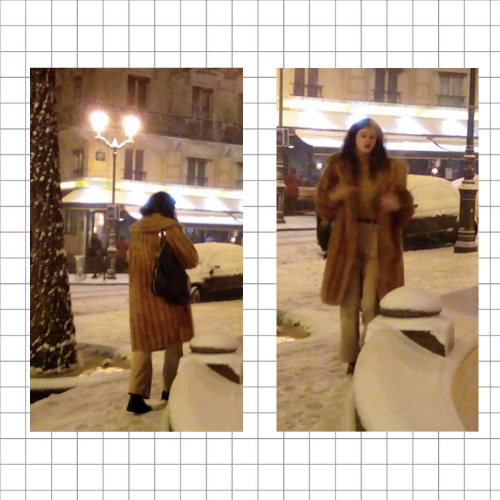My love for real fur was triggered at age five or six. When playing in my grandparents’ house with my cousin, we discovered my late grandmother’s wardrobe. It was just incredible. It had silk dresses, high heels and a beautiful cropped white-rabbit-fur jacket. My cousin and I used to dress up and create short films with my aunt’s camera where we would play worldly women. As we were so little, the jacket fitted us like an ankle-length coat and had this regal feeling that we loved so much.
I still keep my late grandma’s fur jacket in a box and take it out for special occassions
Even though I did not have the chance to know my grandma, I always pictured her as a very elegant woman based on the photos I had seen and her closet I adored. My cousin and I weren’t allowed to bring the jacket home so that we didn’t get jealous: we could only play with it when visiting my grandfather. When he died, I inherited the jacket (my cousin had become a goth and didn’t want it anymore). I still keep this jacket in a protected box and only get it out for special occasions.
In secondary school, fitting in was the only thing that influenced my fashion sense, so I did not wear anything with fur – afraid to stand out, I guess. However, I clearly remember the trend of Canada Goose jackets which had real fur around the hood. I didn’t have one of those because they were so expensive, but my father bought a vintage puffy jacket for me on eBay that had this huge piece of fur around the collar. After several years, I couldn’t keep the jacket because I wore it so much. But fortunately, the collar was removable and I just kept the piece of fur and used it as a scarf. I still have this scarf today and I continue to wear it over a trench coat or stuck inside a sweater as a collar.
If you take care of your fur, never wear it in the rain or store it in a damp room, that piece of fur can last you a lifetime and maybe even your children and grandchildren’s, too. This feeling of eternity is something I really value, and one of the main reasons I like this material so much. I believe fake fur can never come close, because like any other plastic-based item it is made to be disposable and thus after a while the plastic thread will deteriorate.
This feeling of eternity is something I really value
Moving to Paris for university, I discovered a world full of cool charity and vintage shops. As a student, I didn’t have a lot of money but still loved shopping so these shops were the best alternative to treat myself to some new clothes. One day, a friend asked me to accompany him to a little shop in front of the Centre Pompidou museum to try out a big fur coat that he had laid his eyes upon. The coat was an ankle long, yellow and brown marmot fur coat, with a 70s-style oversized collar. It really matched my friend’s cool and original look, but when trying it on, the coat was too short for his arms.
At one point he just told me to try it on and it fitted me perfectly. The price was very low because my friend had already negotiated it with the clerk. I had to buy it. I wore it all winter as it was the warmest coat I had ever owned.
One day, I noticed that inside it there was a small label hidden with the name Jeannine Something beautifully handwritten. I understood the coat must have belonged to a stylish old woman because Jeannine is such an old French name that no one from my generation, or even my parents’, could be called that. In a weird coincidence, it was also the name of my grandmother, which just made me love it even more.

I remember people staring at me in the Metro, and classmates making comments when I would walk into the classroom: “Uh, this is so not vegan”. At first, I felt quite bad about it, but then I thought of the little label with my grandmother’s name on it.
The people that judged me were the same ones bragging about a brand new pair of Nikes made out of plastic that pollutes the oceans. What was, for me, a new coat didn’t produce any kind of pollution or waste, and I knew that it would last longer than any new coat I could ever buy. Because if there is something that I have learned from buying vintage clothing, it is that what has been produced in the past is always likely to be well made, in a local industry. Back then clothes were made to last at least 30 years, because people did not consume the same way we do today. Clothes were not meant to be thrown away, but to be passed onto a friend or the next generation. I’ve worn this coat for six years now and it hasn’t changed: the lining inside got a bit worn at some point, but I just hand-sewed it myself and it looks perfect.
When buying fur, I believe that the most important rule is always to buy it secondhand or vintage, because then you are not responsible for the death of these animals. In my opinion, you are offering a new life to these items and in a way, honouring the animals that have died to make it.

